Trainees report:Kanazawa Training Program:October 10, 2019
Miguel Ángel Echeverría Tager
(2019/10/11)
Our second day of touring the historical quarters of Kanazawa began with an instructive visit to the Kanazawa Institute of Traditional Crafts. As the day before, Mr. Alejandro Falla and Mr. Masahiro Ogawa accompanied us and helped the translator and tour guide, Mr. Toru Taki. Mr. Yochitada Fuchi, Administrative Director of the Institute received us and welcomed us into a classroom where he showed us a presentation with pictures of the training the artisans receive and spoke about the role of an educational institution such as this one in a city where conservation of architecture demands artisan labor. Mr. Carlos González, the trainee that came representing a homologous institution in Guatemala, was most excited about this visit. After we heard the presentation and visited the actual workshops where students train in the art of carpentry, tatami manufacture, roofing, wall construction, and wood, bamboo, paper and tin foil craftsmanship, Mr. Carlos González expressed his gratitude to Mr. Yochitada Fuchi. They both introduced themselves and exchanged presentation cards with the intention of being able to contact each other and possibly work together in the future.
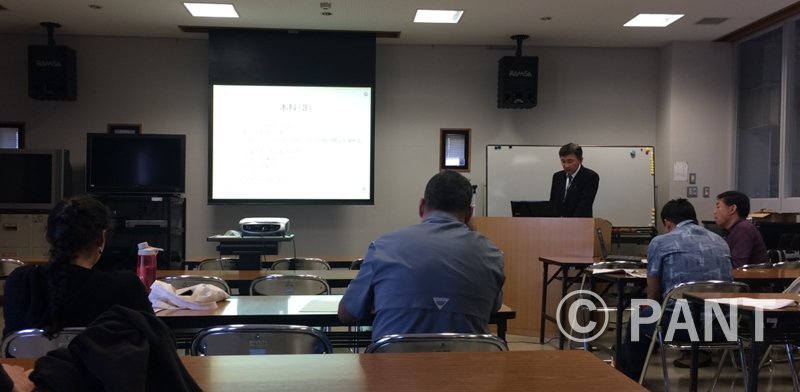
Mr. Yoshitada Fuchi during his presentation. Mr. Carlos González in the front row seat, right behind the translator
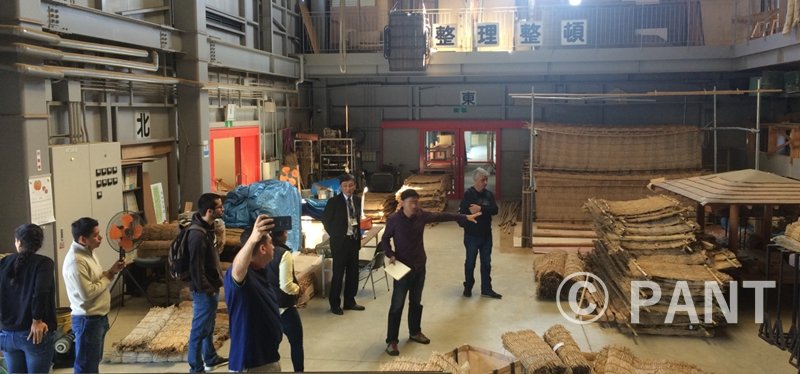
The group of trainees visiting the straw workshop
In the afternoon we began our tour of the samurai districts of Kanazawa with a visit to Nagamachi Yuzenkan, the workshop of kaga yuzen designer Ikkou Teranishi. A very short presentation on the process of manufacturing kaga yuzen was followed by the opportunity to meet the artist who designs the yuzen we had just seen. An artist known beyond the boundaries of Japan, the man we meet was a humble old man that was surprised when I asked him for his autograph. It was a very meaningful gesture that this artist did not use a pen to sign my notebook, but used an ink brush that he carried in his shirt pocket instead.
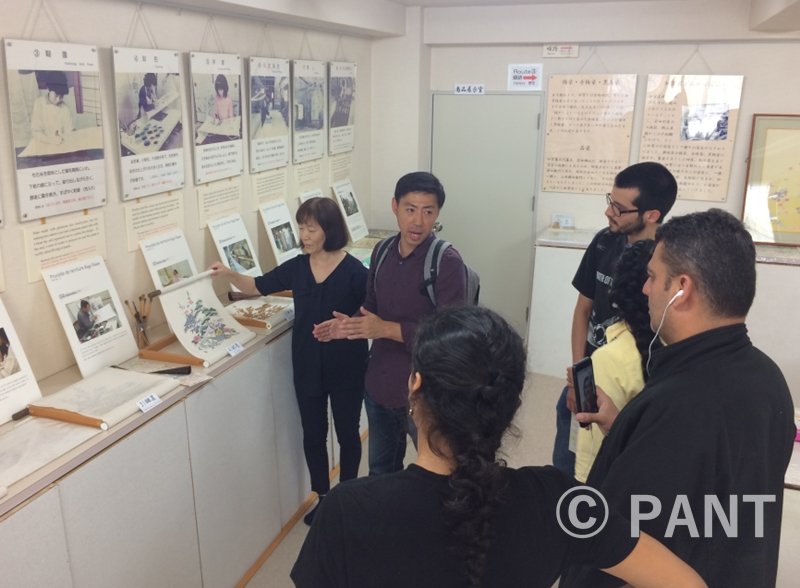
The group of trainees learning the process of dyeing and painting silk
The soft texture of silk and the sublime decoration of the curtains and the kimonos that were on display caught the eyes of Ms. Cristel Pineda and Ms. Ingrid Morales. Secretly, I think, they wished they could try on themselves a kimono to experience the touch of silk and to see how they would look.
Next, we all walked to the samurai house district and visited the reconstructed house of Nomura, a once powerful family. The house is a faithful reconstruction that also offers the view of a beautiful garden in its interior. We had the opportunity to walk on a floor covered with the tatamis that we had seen before in the Kanazawa Institute of Traditional Arts and Crafts, a soft experience for the tired feet of some of the trainees. In a tea room neatly furnished with cushions for sitting on the floor, a kettle, and a couple of cups we were able to take pictures of ourselves seated as the Japanese do when they drink tea. The touristic resource of setting a stage and letting tourists participate of the exhibition instead of just observing it passively seemed to be the most popular attraction of the house, something we all noted.

Mr. Francisco Cano offering tea to Ms. Cristel Pineda at the Site of the Samurai House
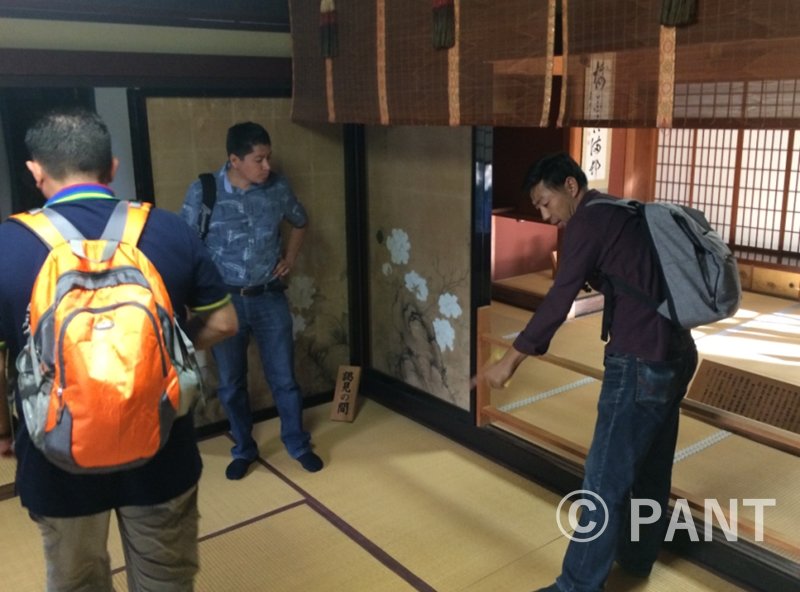
Mr. Toru Taki, translator and tour guide, explaining to Mr. Carlos González the different types of tatamis
While some kept touring the house, I took the time to go back to the garden and delight in the peaceful atmosphere it evoked. It will never cease to amaze me how, even in the smallest spaces, life is kept in harmony with nature in this city. While we were leaving the house we commented on the efficient use of space in architectural design that has remained a constant throughout Japanese architecture. Just like a samurai house built centuries ago, today´s public spaces are also designed and distributed with mathematical precision, an observation we will definitely ponder on when we go back to Guatemala and continue with the project that brought us here. This is one of the many lessons not learned in a classroom, one of the lessons that this visit to Japan has already left us.
Walking around the samurai house district seemingly lost, we were surprised by an image of Jesus Christ coming out of a garden. We followed a trail and found one of the very few Christian churches in this city (the only other Christian church we have found is one we always see from the bus on our way to Kakuma Campus). Entering a Christian church brought every one of us back to realizing how far the West is from the East. Half of the church had the usual benches found on any churches on the West, the other half had tatamis. Side by side, East and West were never better portrayed.
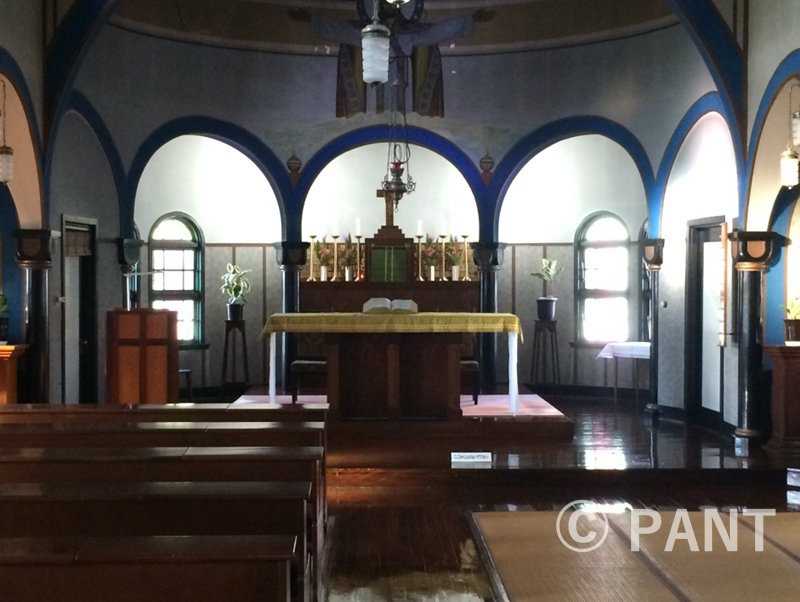
Catholic church near Sirei Hospital, in the Nagamachi neighborhood
To finish the day´s tour we headed to the Nagaya district, to Nishi Chayagai, the other historical quarter where geishas still offer their services. This time, a local guide took us to visit the Shiryokan Museum and took us to see the reconstruction of a real geisha house with multiple independent entrances and exits from a small theater like hall where geishas performed and entertained men. We learned that under the policies of preservation of historical buildings, teahouses such as the one where the Shiryokan Museum is located must conform to certain specifications, especially regarding the façade´s blinds.
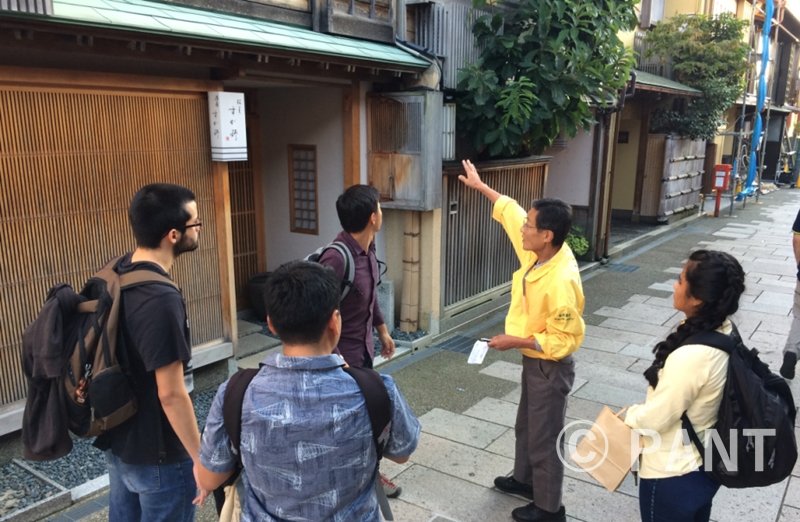
The group of trainees walking around Nishi Chayagai hearing the explanation of the building´s façade from the tour guide before entering the Shiryokan Museum
Walking around the quieter side of Nishi Chayagai we heard music that did not sound familiar to our western ears. We figured out that we were walking past a geisha school and that future geishas were learning how to play the shamisen. We had just seen this stringed instrument in the museum and we stood in silence hearing the free concert while we opened our ears to the sounds and structures of traditional Japanese music, yet another instance of West meets East.
